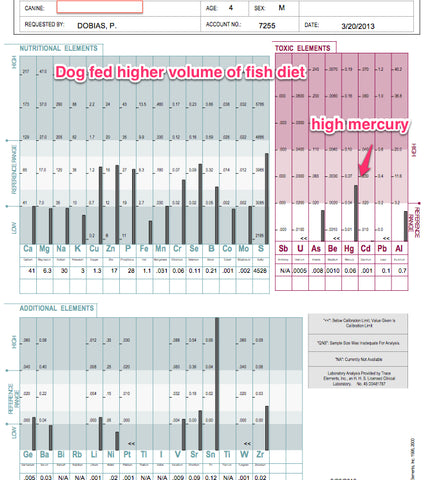
Are fish and fish oils safe for my dog?
Contents
Not so long ago fish and fish based Omega-3 oils were the cornerstone of good health, and considered to be safe and abundant. Unfortunately, times have changed, and finding a good source of sustainable, mercury and radioactive pollution-free Omega-3 is not unlike looking for a needle in a haystack.
Ocean pollution has reached unprecedented levels, which prompted me to look for an inexpensive low-cost method for determining levels of heavy metals and healthy minerals in the body. Hair testing was exactly what I was looking for.
Is there a connection between high mercury levels and epilepsy?
When I started comparing the results of dogs with high mercury levels, I noticed one of these dogs also had a history of seizures, which made me curious. I went back through the files of my other epilepsy patients and found several other dogs that were on a fish diet had epilepsy. The HairQ Test results of many of these dogs also showed abnormal mercury levels.
Tens of thousands of tests later, I have gained a better understanding of just how unsafe fish is. Mercury is a known neurotoxin and its connection to epilepsy should be no surprise. Here are more details of clinical symptoms induced by mercury toxicity.
There also appears to be a link between elevated levels of radioactive strontium 90 in dogs eating sardines.
Below are a few examples: (if you are viewing this email on your mobile device, you will need to download images)


Is there a way to eliminate mercury and other toxins from your dog’s body?
There is a general misconception that it takes a long time to eliminate mercury from the body. In practice, I’ve seen many most dogs reduce their mercury levels to normal by using the following
5 STEP MERCURY CLEANSE PLAN
- Stop feeding fish and fish treats. If you give fish oils, ensure they come from a mercury-free source.
- If you’re wondering what your dog’s mercury levels are, test your dog’s hair using a HairQ Test. I recommend running a test once or twice a year, depending on previous test results.
- Ideally avoid kibble, canned food, or low-grade meat. Remember that cheap meat is produced by feeding cheap feed, which often comes from third-world countries where quality control can be much lower. Such feed is more likely to be contaminated.
- Stop feeding fish or dehydrated liver treats. If you’ve been feeding fish or dehydrated liver treats, you can give your dog a HairQ Test to see what their contamination level is. As a side note – liver is the detoxification organ of the body and feeding even small amounts of dehydrated liver can add up over time.
- Start a six week course of Liver Support and Cleanse (LiverTune) – an herbal formula cleanse that I recommend doing every six months (use for four weeks for follow-up cleanses).
SHOULD OTHER SUPPLEMENTS BE GIVEN DURING A CLEANSE?
- If your dog has been getting the essential supplements prior to the cleanse, there is no need to stop providing them during the cleanse.
- If your dog has never been on any supplements, there is a benefit to supplementing trace minerals and vitamins, as they play a key role in the detox process. Vitamins boost the enzymatic pathways and minerals have the ability to push heavy metals out of the body.
- Refer to the Healthy Dog Tool for more information on what supplements are suitable for your dog.
How often do you need to repeat the cleanse?
The cleanse repetition depends partially on the level of toxicity. Generally, I take my dog through a cleanse every six months, however, it can be done more frequently if your dog’s HairQ Test confirms that mercury levels are high.
Most people notice the positive effects on their dogs’ health, such as a rise in energy levels, better mobility, good digestion, endurance, stamina, skin and coat health, and improved immune system function
Is it good to repeat the HairQ Test?
If your dog has a history of elevated mercury levels before doing a cleanse, it is good to wait about 4 months and then check your dog’s levels by doing a HairQ Test again. If the levels do not change, it is important to look into other potential sources of heavy metal exposure, such as treats, or water.
Is molecular filtration a solution to eliminate mercury from oils?
At first glance this could a be a good solution, however, oil high in mercury is more likely to contain other accumulated chemicals that may not be filtered out.
However, even with a highly efficient molecular filtration process, one issue remains, and that is overfishing and fish stock depletion which must not be ignored.
What are the alternatives to fish based oils?
A few years back, I was faced with this question. I knew that Omega-3s were important, yet I didn’t want to give my dog fish oils.
It took two years to find a sustainable mercury free source, click for more info.
Further reading on this topic:
Toxicokinetics of mercury in blood compartments and hair of fish-fed sled dogs (2011)
Low dose mercury toxicity and human health (2005)
© Dr. Peter Dobias, DVM
